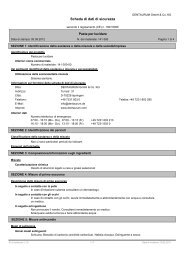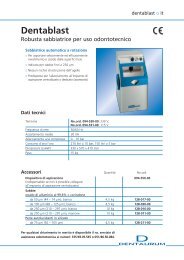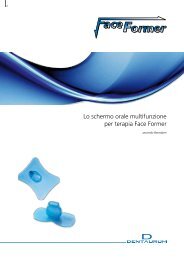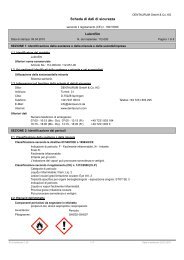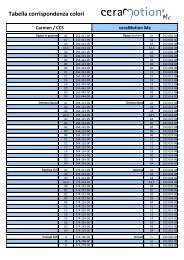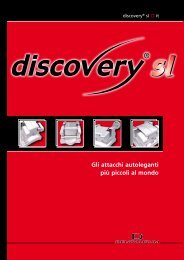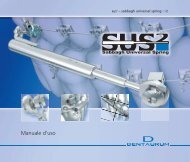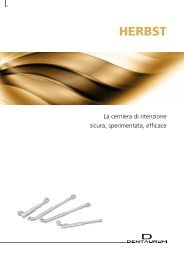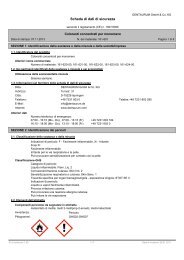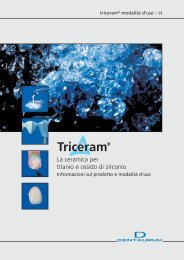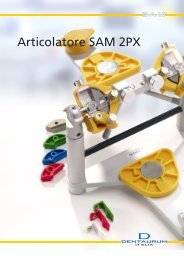Tabelle cottura ceramica
Tabelle cottura CCS.pdf - Dentaurum Italia
Tabelle cottura CCS.pdf - Dentaurum Italia
Create successful ePaper yourself
Turn your PDF publications into a flip-book with our unique Google optimized e-Paper software.
<strong>Tabelle</strong> <strong>cottura</strong> <strong>ceramica</strong><br />
Programma standard:<br />
Temp.<br />
iniziale<br />
Asciugatura<br />
Ossidazione come da istruzione della lega impiegata<br />
Opaco <strong>cottura</strong> 1 + 2<br />
Opaco univ. in pasta<br />
Massa spalla<br />
Cottura 1 + 2<br />
Salita<br />
°C/min<br />
Inizio<br />
vuoto<br />
Fine<br />
vuoto<br />
Temp.<br />
finale<br />
500°C 6 min. 75°C 500°C 930°C 930°C<br />
550°C 6 min. 65°C 550°C 900°C 900°C<br />
Dentina <strong>cottura</strong> 1 550°C 6 min. 65°C 550°C 870°C 870°C<br />
Dentina <strong>cottura</strong> 2 550°C 5 min. 65°C 550°C 870°C 870°C<br />
Glasure 550°C 4 min. 75°C - - 870°C<br />
Manten.<br />
1 min.<br />
no vuoto<br />
1 min.<br />
no vuoto<br />
1 min.<br />
no vuoto<br />
1 min.<br />
no vuoto<br />
1 min.<br />
no vuoto<br />
I dati soprariportati sono validi per forni ben calibrati. Tempi di asciugatura più lunghi ottimizzano il risultato.<br />
Austromat M<br />
Opaco <strong>cottura</strong> 1 + 2<br />
Opaco univ. in pasta<br />
Massa spalla<br />
Cottura 1 + 2<br />
START VAC<br />
LEVEL<br />
°C<br />
<br />
min:sec<br />
END<br />
<br />
min:sec<br />
500°C 0 6 0 9 75°C 930°C 1:00 0 0<br />
550°C 0 6 0 9 65°C 900°C 1:00 0 0<br />
(V)<br />
<br />
1<br />
2<br />
<br />
Dentina <strong>cottura</strong> 1 550°C 0 4 2 9 65°C 870°C 1:00 0 0<br />
Dentina <strong>cottura</strong> 2<br />
Correzione<br />
550°C 0 3 2 9 65°C 870°C 1:00 0 0<br />
Glasure 550°C 0 4 0 0 75°C 870°C 1:00 0 0<br />
Austromat 3001<br />
Opaco <strong>cottura</strong> 1 + 2<br />
Opaco univ. in pasta<br />
C500 T360 . L9 V9 TO75 . C930 V0 T60 CO LO T2 C500<br />
Massa spalla <strong>cottura</strong> 1 + 2 C550 T360 . L9 V9 TO65 . C900 V0 T60 CO LO T2 C550<br />
Dentina <strong>cottura</strong> 1 C550 T240 T120 . L9 V9 TO65 . C870 V0 T60 CO LO T2 C550<br />
Dentina <strong>cottura</strong> 2<br />
Correzione<br />
C550 T300 T120 . L9 V9 TO65 . C870 V0 T60<br />
CO LO T2 C550<br />
Glasure C550 T240 . L9 TO75 . C870 T60-T120 CO LO T2 C550<br />
_______________________________________________________________________________________________<br />
Dentaurum Italia S.p.a. Pag. 1 di 3 Data dell’informazione: 13/09/06
<strong>Tabelle</strong> <strong>cottura</strong> <strong>ceramica</strong><br />
Multimat MCII (Mach1/Mach2)<br />
Opaco <strong>cottura</strong> 1 + 2<br />
Opaco univ. in pasta<br />
Massa spalla<br />
Cottura 1 + 2<br />
Temp.<br />
iniziale<br />
Asciugatura<br />
(min.)<br />
Preriscaldo<br />
(min.)<br />
Vuoto<br />
(min.)<br />
Cottura<br />
(min.)<br />
Temper.<br />
<strong>cottura</strong><br />
Salita<br />
/min.<br />
Vuoto<br />
500°C 5 1 1,0 2,0 930°C 75°C 50°C<br />
500°C 5 1 1,0 2,0 920°C 50°C 50°C<br />
Dentina <strong>cottura</strong> 1 500°C 5 1 1,0 2,0 880°C 50°C 50°C<br />
Dentina <strong>cottura</strong> 2 500°C 4 1 1,0 2,0 880°C 50°C 50°C<br />
Glasure 500°C 3 1 - 1,5-3,0 880°C 75°C -<br />
P90/P95<br />
Opaco <strong>cottura</strong> 1 + 2<br />
Opaco univ. in pasta<br />
Temper.<br />
iniziale<br />
Salita<br />
/min.<br />
Temper.<br />
<strong>cottura</strong><br />
Tempo<br />
chiusura<br />
(min.)<br />
Mantenimento<br />
Vuoto<br />
ON<br />
Vuoto<br />
OFF<br />
400°C 75°C 930°C 8* 1 400°C 929°C<br />
Massa spalla <strong>cottura</strong> 1 + 2 550°C 65°C 900°C 5 1 550°C 899°C<br />
Dentina <strong>cottura</strong> 1 550°C 65°C 870°C 6 1 550°C 869°C<br />
Dentina <strong>cottura</strong> 2<br />
Correzione<br />
550°C 65°C 870°C 6 1 550°C 869°C<br />
Glasure 550°C 75°C 870°C 4 1-3 - -<br />
* 8 min. tempo di chiusura (in funzione del forno)<br />
Vacumat<br />
Opaco <strong>cottura</strong> 1 + 2<br />
Opaco univ. in pasta<br />
Temperatura<br />
finale<br />
Tempo di<br />
essiccazione<br />
(min.)<br />
Salita<br />
Mantenimento<br />
Vuoto<br />
(min.)<br />
Raffreddamento<br />
930°C 6 7 1 7 -<br />
Massa spalla <strong>cottura</strong> 1 + 2 900°C 5 7 1 7 -<br />
Dentina <strong>cottura</strong> 1 870°C 6 6 1 6 -<br />
Dentina <strong>cottura</strong> 2 870°C 6 6 1 6 -<br />
Glasure <strong>cottura</strong> 1 870°C 4 5 1-3 - -<br />
_______________________________________________________________________________________________<br />
Dentaurum Italia S.p.a. Pag. 2 di 3 Data dell’informazione: 13/09/06
<strong>Tabelle</strong> <strong>cottura</strong> <strong>ceramica</strong><br />
Osservazioni:<br />
• Le leghe ad alto titolo devono essere eventualmente trattate con acido dopo la <strong>cottura</strong> di ossidazione<br />
(vedi istruzioni del produttore).<br />
• Il sistema CCS non richiede l’impiego di materiali per la glasure. In generale, la glasure può essere<br />
ottenuta prolungando la permanenza della <strong>ceramica</strong> nel forno.<br />
Note:<br />
I valori riportati rappresentano solo delle linee guida e dovrebbero essere adattate individualmente<br />
in funzione della specifica situazione, età e tipologia del forno impiegato.<br />
Le tabelle di <strong>cottura</strong> si riferiscono a forni appena calibrati.<br />
Tutti i dati sono stati redatti con la dovuta diligenza, tuttavia non possono essere garantiti.<br />
Controllo del forno:<br />
al fine di adattare le temperature del proprio forno, raccomandiamo l’esecuzione di uno specifico test che<br />
permetta la corretta valutazione della sequenza di <strong>cottura</strong>. A tal fine, viene impiegato il neutro trasparente NT<br />
CCS miscelato con liquido di modellazione universale LV+ e trattato alle seguenti condizioni:<br />
• temperatura iniziale: 500°C<br />
• tempo di essiccazione: 8 minuti<br />
• velocità di salita: 50°C/min.<br />
• inizio vuoto: 500°C<br />
• fine vuoto alla temperatura finale: 870°C<br />
• mantenimento: 1 minuto in atmosfera<br />
Appoggiare il campione su un foglio di platino e non sul cotone refrattario in quanto potrebbe causare<br />
l’opalescenza. La temperatura del forno è corretta se il campione si presenta chiaro e trasparente con angoli<br />
vivi. Se la temperatura finale è troppo alta, la superficie del campione si presenta lucida e gli angoli poco<br />
definiti. Se la temperatura finale è troppo bassa, il campione appare bianco latte. In funzione del risultato<br />
ottenuto, aumentare o diminuire la temperatura finale di 10°C alla volta e ripetere il test di <strong>cottura</strong>.<br />
Importante:<br />
per evitare che il forno incameri umidità, dopo l’uso chiudere la camera di <strong>cottura</strong> o impostare la modalità<br />
notte.<br />
_______________________________________________________________________________________________<br />
Dentaurum Italia S.p.a. Pag. 3 di 3 Data dell’informazione: 13/09/06



